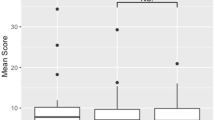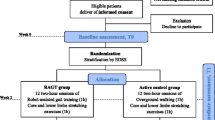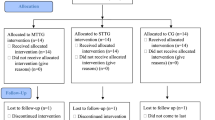Abstract
Background
Rehabilitation seems to promote brain plasticity, but objective measures of efficacy are lacking and there is a limited understanding of the mechanisms underlying functional recovery.
Objective
To study functional and structural brain changes induced by gait rehabilitation.
Methods
We enrolled MS inpatients (EDSS 4.5–6.5) undergoing a 4-week neurorehabilitation. Several clinical measures were obtained, including: 2-min walk test (2MWT), dynamic gait index (DGI), Berg balance scale (BBS). Furthermore, motor-task functional MRI (fMRI) of plantar dorsiflexion, resting state fMRI, and regional diffusion tensor imaging (DTI) metrics were obtained. All the assessments were performed at baseline (T0), after the end of the rehabilitation period (T1) and 3 months later (T2).
Results
Twenty-nine patients were enrolled at T0, 26 at T1, and 16 completed all timepoints. At T1, there was a significant improvement of 2MWT, DGI, and BBS scores, along with a reduced extent of the widespread activation related to the motor task at the fMRI and an increased functional connectivity in the precentral and post-central gyrus, bilaterally. None of these changes were maintained at T2.
Conclusions
Our findings show a short-term beneficial effect of motor rehabilitation on gait performances in MS, accompanied by brain functional reorganization in the sensory-motor network.




Similar content being viewed by others
References
Ontaneda D, Thompson AJ, Fox RJ, Cohen JA (2017) Progressive multiple sclerosis: prospects for disease therapy, repair, and restoration of function. Lancet 389(10076):1357–1366
Khan F, Turner-Stokes L, Ng L, Kilpatrick T (2007) Multidisciplinary rehabilitation for adults with multiple sclerosis. Cochrane Database Syst Rev 2:CD006036
Motl RW, Sandroff BM, Kwakkel G, Dalgas U, Feinstein A, Heesen C et al (2017) Exercise in patients with multiple sclerosis. Lancet Neurol. 16(10):848–856
Reddy H, Narayanan S, Arnoutelis R, Jenkinson M, Antel J, Matthews PM et al (2000) Evidence for adaptive functional changes in the cerebral cortex with axonal injury from multiple sclerosis. Brain 123(Pt 11):2314–2320
Lee M, Reddy H, Johansen-Berg H, Pendlebury S, Jenkinson M, Smith S et al (2000) The motor cortex shows adaptive functional changes to brain injury from multiple sclerosis. Ann Neurol 47(5):606–613
Rocca MA, Colombo B, Falini A, Ghezzi A, Martinelli V, Scotti G et al (2005) Cortical adaptation in patients with MS: a cross-sectional functional MRI study of disease phenotypes. Lancet Neurol 4(10):618–626
Mezzapesa DM, Rocca MA, Rodegher M, Comi G, Filippi M (2008) Functional cortical changes of the sensorimotor network are associated with clinical recovery in multiple sclerosis. Hum Brain Mapp 29(5):562–573
Tomassini V, Matthews PM, Thompson AJ, Fuglo D, Geurts JJ, Johansen-Berg H et al (2012) Neuroplasticity and functional recovery in multiple sclerosis. Nat Rev Neurol 8(11):635–646
Prosperini L, Piattella MC, Gianni C, Pantano P (2015) Functional and structural brain plasticity enhanced by motor and cognitive rehabilitation in multiple sclerosis. Neural Plast 2015:481574
De Giglio L, Tona F, De Luca F, Petsas N, Prosperini L, Bianchi V et al (2016) Multiple sclerosis: changes in thalamic resting-state functional connectivity induced by a home-based cognitive rehabilitation program. Radiology 280(1):202–211
Chiaravalloti ND, Wylie G, Leavitt V, Deluca J (2012) Increased cerebral activation after behavioral treatment for memory deficits in MS. J Neurol 259(7):1337–1346
Cerasa A, Gioia MC, Valentino P, Nistico R, Chiriaco C, Pirritano D et al (2013) Computer-assisted cognitive rehabilitation of attention deficits for multiple sclerosis: a randomized trial with fMRI correlates. Neurorehabil Neural Repair 27(4):284–295
Parisi L, Rocca MA, Valsasina P, Panicari L, Mattioli F, Filippi M (2014) Cognitive rehabilitation correlates with the functional connectivity of the anterior cingulate cortex in patients with multiple sclerosis. Brain Imaging Behav 8(3):387–393
Parisi L, Rocca MA, Mattioli F, Copetti M, Capra R, Valsasina P et al (2014) Changes of brain resting state functional connectivity predict the persistence of cognitive rehabilitation effects in patients with multiple sclerosis. Mult Scler 20(6):686–694
Rasova K, Prochazkova M, Tintera J, Ibrahim I, Zimova D, Stetkarova I (2015) Motor programme activating therapy influences adaptive brain functions in multiple sclerosis: clinical and MRI study. Int J Rehabil Res 38(1):49–54
Rasova K, Krasensky J, Havrdova E, Obenberger J, Seidel Z, Dolezal O et al (2005) Is it possible to actively and purposely make use of plasticity and adaptability in the neurorehabilitation treatment of multiple sclerosis patients? A pilot project. Clin Rehabil 19(2):170–181
Tomassini V, Johansen-Berg H, Jbabdi S, Wise RG, Pozzilli C, Palace J et al (2012) Relating brain damage to brain plasticity in patients with multiple sclerosis. Neurorehabil Neural Repair 26(6):581–593
Ibrahim I, Tintera J, Skoch A, Jiru F, Hlustik P, Martinkova P et al (2011) Fractional anisotropy and mean diffusivity in the corpus callosum of patients with multiple sclerosis: the effect of physiotherapy. Neuroradiology 53(11):917–926
Bonzano L, Tacchino A, Brichetto G, Roccatagliata L, Dessypris A, Feraco P et al (2014) Upper limb motor rehabilitation impacts white matter microstructure in multiple sclerosis. Neuroimage 90:107–116
Prosperini L, Fanelli F, Petsas N, Sbardella E, Tona F, Raz E et al (2014) Multiple sclerosis: changes in microarchitecture of white matter tracts after training with a video game balance board. Radiology 273(2):529–538
Salimi-Khorshidi G, Douaud G, Beckmann CF, Glasser MF, Griffanti L, Smith SM (2014) Automatic denoising of functional MRI data: combining independent component analysis and hierarchical fusion of classifiers. Neuroimage 90:449–468
Filippini N, MacIntosh BJ, Hough MG, Goodwin GM, Frisoni GB, Smith SM et al (2009) Distinct patterns of brain activity in young carriers of the APOE-epsilon4 allele. Proc Natl Acad Sci USA. 106(17):7209–7214
Bergsland N, Lagana MM, Tavazzi E, Caffini M, Tortorella P, Baglio F et al (2015) Corticospinal tract integrity is related to primary motor cortex thinning in relapsing–remitting multiple sclerosis. Mult Scler 21(14):1771–1780
Smith SM, Jenkinson M, Johansen-Berg H, Rueckert D, Nichols TE, Mackay CE et al (2006) Tract-based spatial statistics: voxelwise analysis of multi-subject diffusion data. Neuroimage 31(4):1487–1505
Rocca MA, Gavazzi C, Mezzapesa DM, Falini A, Colombo B, Mascalchi M et al (2003) A functional magnetic resonance imaging study of patients with secondary progressive multiple sclerosis. Neuroimage 19(4):1770–1777
Barkhof F (2002) The clinico-radiological paradox in multiple sclerosis revisited. Curr Opin Neurol 15(3):239–245
Filippi M, Preziosa P, Rocca MA (2017) Brain mapping in multiple sclerosis: lessons learned about the human brain. Neuroimage. https://doi.org/10.1016/j.neuroimage.2017.09.021
Groppo E, Baglio F, Cattaneo D, Tavazzi E, Bergsland N, Di Tella S et al (2017) Multidisciplinary rehabilitation is efficacious and induces neural plasticity in multiple sclerosis even when complicated by progressive multifocal leukoencephalopathy. Front Neurol 8:491
Morgen K, Kadom N, Sawaki L, Tessitore A, Ohayon J, McFarland H et al (2004) Training-dependent plasticity in patients with multiple sclerosis. Brain 127(Pt 11):2506–2517
Boutiere C, Rey C, Zaaraoui W, Le Troter A, Rico A, Crespy L et al (2017) Improvement of spasticity following intermittent theta burst stimulation in multiple sclerosis is associated with modulation of resting-state functional connectivity of the primary motor cortices. Mult Scler 23(6):855–863
Motl RW, McAuley E, Snook EM (2005) Physical activity and multiple sclerosis: a meta-analysis. Mult Scler 11(4):459–463
Draganski B, Gaser C, Busch V, Schuierer G, Bogdahn U, May A (2004) Neuroplasticity: changes in grey matter induced by training. Nature 427(6972):311–312
Boyke J, Driemeyer J, Gaser C, Buchel C, May A (2008) Training-induced brain structure changes in the elderly. J Neurosci 28(28):7031–7035
Filippi M, Ceccarelli A, Pagani E, Gatti R, Rossi A, Stefanelli L et al (2010) Motor learning in healthy humans is associated to gray matter changes: a tensor-based morphometry study. PLoS ONE 5(4):e10198
Pardini M, Bonzano L, Bergamino M, Bommarito G, Feraco P, Murugavel A et al (2015) Cingulum bundle alterations underlie subjective fatigue in multiple sclerosis. Mult Scler 21(4):442–447
Acknowledgements
This study was supported by a grant from Fondazione Italiana Sclerosi Multipla (FISM) (Grant # 2013/R/26).
Author information
Authors and Affiliations
Corresponding author
Ethics declarations
Conflicts of interest
All authors report no disclosures.
Ethical statement
The study has been approved by the local ethics committee and has, therefore, been performed in accordance with the ethical standards laid down in the 1964 Declaration of Helsinki and its later amendments.
Informed consent
All the subjects recruited in the study gave their written informed consent prior to their inclusion in the study.
Electronic supplementary material
Below is the link to the electronic supplementary material.
Rights and permissions
About this article
Cite this article
Tavazzi, E., Bergsland, N., Cattaneo, D. et al. Effects of motor rehabilitation on mobility and brain plasticity in multiple sclerosis: a structural and functional MRI study. J Neurol 265, 1393–1401 (2018). https://doi.org/10.1007/s00415-018-8859-y
Received:
Revised:
Accepted:
Published:
Issue Date:
DOI: https://doi.org/10.1007/s00415-018-8859-y




